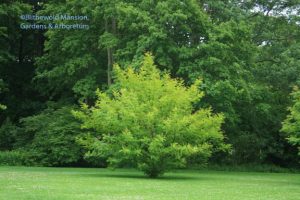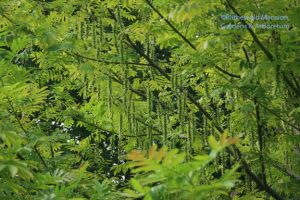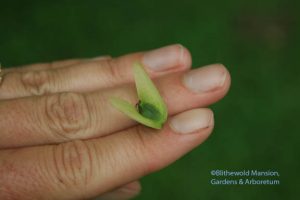Fringe benefits
 I want to make it very clear that no matter how hot and awful it is outside right now I am not ready for fall. So just in case you’ve got your hand on the season machine dial, please don’t turn it yet on my account. But even if we’re not ready for it, there are a few gentle hints of a change that are hard to ignore – dark mornings, lengthening light in the afternoon, and that one little red branch on all of the tupelos. Fall is for the trees but if you don’t mind I’d like to draw your attention away from the gardens (as if!) for a quick minute now – a little early, I know – to show off a tree I’ve never before mentioned on the blog and quickly tell you about a must-do up-coming event.
I want to make it very clear that no matter how hot and awful it is outside right now I am not ready for fall. So just in case you’ve got your hand on the season machine dial, please don’t turn it yet on my account. But even if we’re not ready for it, there are a few gentle hints of a change that are hard to ignore – dark mornings, lengthening light in the afternoon, and that one little red branch on all of the tupelos. Fall is for the trees but if you don’t mind I’d like to draw your attention away from the gardens (as if!) for a quick minute now – a little early, I know – to show off a tree I’ve never before mentioned on the blog and quickly tell you about a must-do up-coming event.
With a name like “Wingnut”, it’s actually surprising I haven’t mentioned this tree since that’s my favorite term of endearment for all of the loons in my circle of friends and family. But our little trio of Chinese wingnuts or Pterocarya stenoptera didn’t even show up on my radar until sometime in the last couple-three years. And then, just last week, Fred pointed out that one of them was all dressed up in nuts.
 I had thought the wingnut was a big shrub or a small tree since ours are branched out low and very nearly spherical in shape. But if I think back, it seems they have been growing at a fairly prodigious rate and according to everything I’ve read, they’re destined to become enormous shade trees “which can be successfully used for large areas such as parks, schools, and golf courses…” according to Michael Dirr in his Manual of Woody Landscape Plants. So this is probably not a tree you’ll thank me for recommending for your own garden – unless you happen to have acres of park. We might have to be content with watching them grow here.
I had thought the wingnut was a big shrub or a small tree since ours are branched out low and very nearly spherical in shape. But if I think back, it seems they have been growing at a fairly prodigious rate and according to everything I’ve read, they’re destined to become enormous shade trees “which can be successfully used for large areas such as parks, schools, and golf courses…” according to Michael Dirr in his Manual of Woody Landscape Plants. So this is probably not a tree you’ll thank me for recommending for your own garden – unless you happen to have acres of park. We might have to be content with watching them grow here.
 Chinese wingnuts are members of the walnut family (Juglandaceae) and prefer the usual cultural requirements – you know, fertile, moist well drained soil in full sun – but can tolerate tougher conditions once established and are hardy from USDA zones 6-9. Their feature of note and the reason I’ve pulled this post away from the gardens is that inconspicuous spring flowers are followed by the coolest strands of dangling nuts. Long pendulous chains fall from each branch like the fringe on a cowboy’s jacket. And the individual winged nuts look like they could just fly away. But before they fly, they’ll hang on for a while and turn brown as the tree’s lacy foliage turns yellow in the fall. Do you know this tree? Have you seen one full grown and bedecked?
Chinese wingnuts are members of the walnut family (Juglandaceae) and prefer the usual cultural requirements – you know, fertile, moist well drained soil in full sun – but can tolerate tougher conditions once established and are hardy from USDA zones 6-9. Their feature of note and the reason I’ve pulled this post away from the gardens is that inconspicuous spring flowers are followed by the coolest strands of dangling nuts. Long pendulous chains fall from each branch like the fringe on a cowboy’s jacket. And the individual winged nuts look like they could just fly away. But before they fly, they’ll hang on for a while and turn brown as the tree’s lacy foliage turns yellow in the fall. Do you know this tree? Have you seen one full grown and bedecked?
Since I went and mentioned fall… Please mark September 28th on your calendar because, co-sponsored with the New England Chapter of the International Society of Arboriculture, the one and only Michael Dirr is coming to Blithewold for a day of slideshow lectures and a tree tour of the property. I can’t imagine missing that! For more information, click here.
